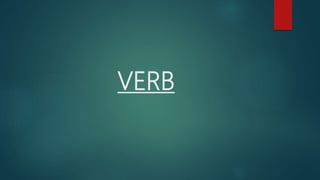
Verbs
- 1. VERB
- 2. Definition:- “Verb is a word that shows an action or a state.” Examples:- (a) He is eating. (b) He runs. (c) He is walking. (d) Plane is at rest. TYPES OF VERBS * Stative (State) and Dynamic (Action) verbs. * Main and Helping (Auxiliary and modals) verbs. * Transitive and Intransitive verbs. * Linking verbs (Copulas). * Regular and irregular. * Finite and Non-Finite verbs.
- 3. a) Stative(State) and Dynamic(Action) Verbs Stative(State) verbs:- “State verb is a word that expresses an action.” State verbs are not physical. We can’t see a state verb. State verbs are not used with continuous tenses. These verbs are used with simple tenses. e.g believe, understand, like etc. • I believe you. We can’t say (I am believing you) • I understand. We can’t say (I am understanding you) • Julia likes chocolate ice cream. We can’t say (Julia is liking chocolate ice cream) Dynamic(Action) verbs:- “Such verbs which expresses physical activities or processes”. We can see the action. These verbs can be used in all tenses. e.g kick, shout, run, eat etc. • I eat dinner every day. OR . I am eating dinner. • He plays. OR . The children are playing in the park. • He runs. OR . He is running.
- 4. b) Main and Helping (Auxiliary and Modals) verbs Main verb:- Main word in a sentence on which whole sentence depends. e.g • Ali is working now. • He is eating. • John is playing.
- 5. Helping (auxiliary and Modals) verbs Auxiliary verbs:- There are three main auxiliary verbs be, do, have. Imp: be : continuous tenses do : simple tenses have : perfect tenses e.g Andy is working now. I do not play golf every weekend. We have visited the UK four times. In some cases Auxiliary verbs can be used as main verbs. e.g We have a car. Modals:- “Modals helps us to express mood in a sentence.” Mood means attitude of the speaker. Modals: can, could, may, might, will, would, shall, should, must e.g The Patriots might win the Super Bowl this year. (Here might shows hope) You mustn’t smoke here. (Here mustn’t shows you don’t have permission) My sister can play guitar. (Here play is main verb and can shows its ability)
- 6. c) Transitive and Intransitive verbs Transitive verb:- “A transitive verb always takes an object.” Object is a noun or pronoun that receives action. e.g hit, give, carry, climb, make, kiss, take etc. • Ali kicked. (Ali kicked what?) Ali kicked the ball. (The ‘ball’ is the object of the verb ‘kick’ because ‘the ball’ receives the ‘kick’ so, ‘kick’ is transitive verb). Intransitive verb:- “A verb that does not take an object.” e.g live, die, laugh, cry, run, sleep, sit, stand etc. • The old man laughed loudly.
- 7. d) Linking verbs(copulas) Definition:- “Used to describe a situation or even somebody. For example to list the qualities of something or somebody.” e.g be, prove, appear, smell, look, go, keep, become, get, stay, turn, sound, taste, seem etc. They link the subject & the complement of a statement. e.g Steven looked happy to see me.
- 8. e) Regular & Irregular verbs Regular verb:- “The verbs that end in –d or-ed to indicate an action in the past are called regular verbs.” e.g Irregular verb:- “The verbs that does not end in –d or –ed.” e.g Present tense Touch Kill Pass Rub Stop Past tense Touched Killed Passed Rubbed Stopped Past Participle Touched Killed Passed Rubbed Stopped Present tense Cost Begin Hurt Choose Shut Past tense Cost Began Hurt Chose Shut Past Participle Cost Begun Hurt Chosen Shut
- 9. f) Finite and Non-Finite Verbs Finite verbs:- “Finite verbs must agree with the number and person of its subject.” Finite means bound. e.g • I love studying. (In this sentence finite verb love agrees with the subject ‘I’. ‘I’ is the first person singular) • Kevin loves food. (In this sentence finite verb loves agrees with the subject ‘Kevin’. ‘Kevin’ is the third person singular) If the tense of a sentence changes, then the form of the verb changes. Such a verb is still a finite verb. e.g • He works at a photo shop. (Present simple tense) • He worked at a photo shop. (Past simple tense) A sentence does not make any sense without finite verb.
- 10. Non-Finite verbs:- “Non-Finite verbs are not bound by tense, person or number of the subject.” e.g • Both sentence have finite and non-finite verbs. • ‘Hate’ is the finite verb it is bound by tense, number and person. However the verb ‘working’ is a non- finite verb it does not change even though the number, person and tense of the sentence changes. Non-finite verbs are not bound by subject-verb agreement. Non-finite verbs are an extension of a sentence and sometimes can be left out. Depending on the situation or context, the sentence will still make sense. e.g • We must go shopping now. (With the non-finite verb) • We must go now. (Without the non-finite verb, but still make sense) Richie hates working. My friends hated working.